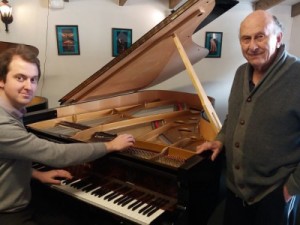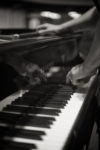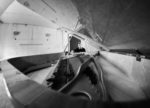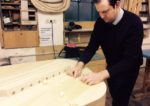Piano Maker’s Corner: Engineering Soundboards With Carbon Fibre
This article was written by Richard Dain. Additional comments, photos, videos etc. by Doug Chapman.
 The best soundboards need to be light weight and very stiff. We, at Hurstwood Farm Piano Studios, have shown it is possible to design a soundboard made of carbon fibre that gives true piano sound quality. Using carbon fibre can result in huge benefits for the durability and longevity of pianos generally. We have also discovered that a thick carbon fibre board gives harsh sound but a thin one produces sound quality that to almost all pianists is indistinguishable from a wooden sound board.
The best soundboards need to be light weight and very stiff. We, at Hurstwood Farm Piano Studios, have shown it is possible to design a soundboard made of carbon fibre that gives true piano sound quality. Using carbon fibre can result in huge benefits for the durability and longevity of pianos generally. We have also discovered that a thick carbon fibre board gives harsh sound but a thin one produces sound quality that to almost all pianists is indistinguishable from a wooden sound board.
Sadly, sufficiently thin CF boards cannot be directly substituted for wooden boards because, being thin, they would collapse under the loads from the strings. That issue is resolved by our now well established Phoenix bridge agraffes that uniquely clamp the string (very firmly) to the bridge without imposing any string loading on the soundboard. (Read our last post about Agraffes here)
The Benefits of CF
Carbon fibre (CF) is immensely strong and stiff for its weight and almost unaffected by temperature change or exposure to moisture. The properties of carbon fibre, when applied to the piano structure, permit pianos of far greater strength and less weight to be designed. Their resulting insensitivity to temperature and moisture offers the potential of climate resistance and longer life. The stability of critical items such as the key bed positively affect the maintenance of fine regulation of the action.
The Challenges of CF
In a conventional piano the strings are tensioned on a cast iron frame. As the material of the steel strings extends with temperature rise, any piano would go very flat were it not for the fact that the cast iron frame expands almost the same amount. this compensation ensures that the tension in the strings and pitch of each note is maintained, virtually unchanged. If that same piano had a similar carbon fibre frame this would not expand to compensate. A 10 degree Celsius temperature rise would cause the piano pitch to drop by about a semitone.
Carbon fibre depends on its strength from a fine matrix of fibres of carbon embedded in and bonded to a matrix of epoxy resin. Sometimes these are woven sheets of fibres and at other times unidirectional fibres are used. The resin positions the fibre, but contributes almost nothing to the strength. But if, after forming, any of the carbon fibres are cut by drilling or other machining, the bonding attachment of the fibre to the resin is disturbed integrity of the component will be seriously impaired.
Lastly, carbon fibre does not withstand surface pressures (bearing loads) well because this puts demands on the resin rather than the fibres. So, items like tuning pins and hitch pins inserted into a carbon fibre frame are a “no go” option. Carbon fibre whilst being far superior to wood in longevity is affected by ultra violet light which weakens the resin and its bonding. (I wonder how safe some of the latest CF aircraft are with their enhanced exposure to UV light in the upper atmosphere?)
So How Did We Solve These Design Issues?
All these matters have been addressed in our new Carbiano. The two part frame has a simple and robust in-built mechanical expansion system that precisely compensates for extension of the strings with rising temperature. Compensation is actually to a higher standard than is possible with a cast iron frame.
Here’s Our Phoenix Carbiano showing off its incredible repetition rate!
What We Actually Did
The key frame of the Carbiano is designed with a carbon fibre foam sandwich which is completely inert to distortion or shape change with moisture or temperature variation. This has been tested and proved to offer improved action regulation stability in adverse climates. Some of you will have experienced the tuning and regulation issues of pianos on board ship and in tropical climates. Our Carbiano will solve that for you!
The action of Carbiano is produced by WNG (www.wessellnickelandgross.com). It uses thin wall tubular carbon fibre shanks of only 4.75mm diameter. These CF shanks are stiffer than conventional wood shanks. High speed photography has demonstrated superior control and uniformity of the geometry as the hammer strikes the string. Consequently the problem of volume ceiling associated with the bending of wooden shanks, that leads to inaccurate location of the strike point, has been eliminated.
In traditionally designed pianos, with an increase in fortissimo playing, sound power is lost as the hammer strike point moves away from the optimal spot. But not with our CF design. The hammer flange bearings are sintered inserts immune to humidity that replace conventional felt.
These assemblies can be soaked under water for many hours and yet still immediately perform perfectly in a piano. Without exception, professional artists who have not first been told Carbiano has this action have remarked that it is superb. Most say they thought it was a conventional action in special state of regulation.
One piano designer has contracted for “extra flexible” carbon fibre shanks to be designed for the WNG actions in his pianos so the hammer is- in his words,“flung against the string”. Our stiffer shank is designed to afford the pianist better feed-back when the hammer strikes the string.
What We Could Have Done
We could have addressed the challenges of pitch stability by developing a piano string steel of near zero expansion with temperature rise, but the cost and means and uncertainty risk of development of such special steel was far beyond our financial and time resources. We considered using a modified form of ”invar” a low strength iron/nickel alloy with very low thermal expansion. Addition of carbon for strength, vanadium for toughness and yttrium or zirconium for elongation resistance would have supplied what we needed for piano strings in a carbon fibre frame.
No doubt others with bigger financial coffers will ”invent this idea” in due course. We already know of one person who has built a copy of a traditional piano frame in carbon fibre. It will be interesting to see if she has developed such low expansion alloy or if her pianos suffer instability of tuning.
What’s Next For Us?
We recently developed a new computer programme using the powerful analytical technique of “finite element stress analysis” to study the effect of the thickness of piano sound boards, the dimensioning and material of bridges, the use or absence of ribs, and the rigidity with which soundboards are fixed to the piano.
The interaction of over 6 million tiny elements of the piano in this study of whole pianos and their parts gave some fascinating insights into piano design. We found that there is advantage in designing soundboards and soundboard systems that have natural frequencies close to the notes being sounded. This is easy in the upper registers of all pianos, but can be difficult but not impossible in the bass registers of baby grands.
Look for new video performances of our Carbiano in action. We will be pushing the instrument to its limit, to show what it is really capable of! And, in our next post, we’ll report from the International Musikmesse in Frankfurt, where we have been exhibiting the Carbiano!


